 If you look carefully, you’ll notice one item on this list is not crossed off; we finally found a food that the magical land of Berkeley could not provide. Of all things, goat. I even called around to butchers and halal meat markets, and the artisan butcher at the market; the best response I got was to “try again around Easter”. And I’m not sure, but I think that’s because the Muslim holiday of Id-al-Adha, at which much goat feasting occurs, might fall in early April(??). I could be wrong, maybe that’s just when baby goats are at their most tender. (Meat is Murder. Tasty, tasty murder.)
If you look carefully, you’ll notice one item on this list is not crossed off; we finally found a food that the magical land of Berkeley could not provide. Of all things, goat. I even called around to butchers and halal meat markets, and the artisan butcher at the market; the best response I got was to “try again around Easter”. And I’m not sure, but I think that’s because the Muslim holiday of Id-al-Adha, at which much goat feasting occurs, might fall in early April(??). I could be wrong, maybe that’s just when baby goats are at their most tender. (Meat is Murder. Tasty, tasty murder.)
The reason I went to the trouble to find a goat’s shoulder is because of the annual article in Food & Wine magazine on the Best New Chefs of the year, in America. The youngest of the 2007 crop is Johnny Monis who makes this Pappardelle with Milk-Roasted Baby Goat Ragù at Komi in Washington, DC, and the description made it irresistible. 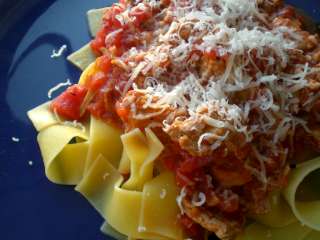 Nevermind that it is the middle of summer and hot as an oven inside our west-facing kitchen in the evenings, I could just imagine the delicate, slightly gamey, savoury taste of this slow-cooked, oven-braised meat over pasta. It had to be done.
Nevermind that it is the middle of summer and hot as an oven inside our west-facing kitchen in the evenings, I could just imagine the delicate, slightly gamey, savoury taste of this slow-cooked, oven-braised meat over pasta. It had to be done.
Upon giving up on the goat, I settled on veal (because something young and innocent had to die in order for me to eat). But there was a pleasant surprise in store for me at the gourmet grocery because when I went to pick out a can of tomatoes, I was amazed to find Rao’s canned tomatoes. I hadn’t thought about that place for years but for awhile, I had kind of had an odd fixation on that particular restaurant in New York. I’ve never been there, never even seen it, but I’ve read enough about its legendary status to be more than a little curious. I read somewhere that reservations are nearly impossible for mere mortals (i.e. me) to obtain and quite hard to get even for immortals (i.e. celebreties). What made the place even more curious is that, if one has enough money and clout, one can own a table at the restaurant, which will be made available immediately upon request. Imagine! Owning a reserved table at a restaurant! Anyway, the idea of an eatery taking things to such an outrageous level stuck with me so when I saw their tomatoes on the shelf here in California, I knew that if I bought them, I could eat like an immortal.
I did indeed braise the meat in milk, as per the recipe, and I let the ragù rest overnight so as to allow the flavours to properly meld, but did not go so far as to hand-make pasta without a pasta machine. I am dedicated to cooking, but not crazy; we picked up dried, organic papparadelle.
 Did I mention that I made bread to go with it? My first ever attempt at bread making: pain à l’ancienne, a crispy, chewy baguette which, by the way, turn into rock solid pieces of fossilized bread if you leave them out overnight wrapped in towel. But I digress. The resulting meal that we enjoyed the following day was marvelously decadent and the only thing that could possibly have made it better was if it was cold outside.
Did I mention that I made bread to go with it? My first ever attempt at bread making: pain à l’ancienne, a crispy, chewy baguette which, by the way, turn into rock solid pieces of fossilized bread if you leave them out overnight wrapped in towel. But I digress. The resulting meal that we enjoyed the following day was marvelously decadent and the only thing that could possibly have made it better was if it was cold outside.
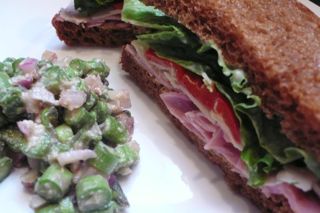 Since we’ve begun baking our own bread, it is only natural that our sandwiches have begun to involve a little more thought and effort. Marc produced a glorious loaf of Anadama bread, which I turned into simple Niman Ranch ham sandwiches with dijon, and a side of raw asparagus salad. That loaf barely lasted a few days, so darkly sweet, even plainly toasted and smeared with butter.
Since we’ve begun baking our own bread, it is only natural that our sandwiches have begun to involve a little more thought and effort. Marc produced a glorious loaf of Anadama bread, which I turned into simple Niman Ranch ham sandwiches with dijon, and a side of raw asparagus salad. That loaf barely lasted a few days, so darkly sweet, even plainly toasted and smeared with butter.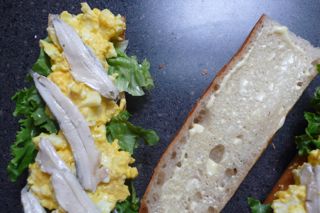
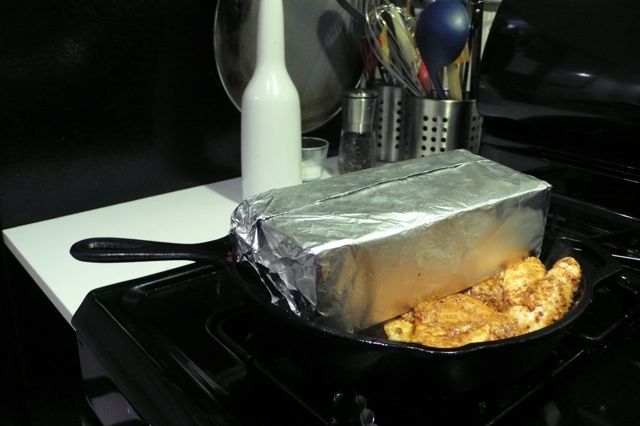
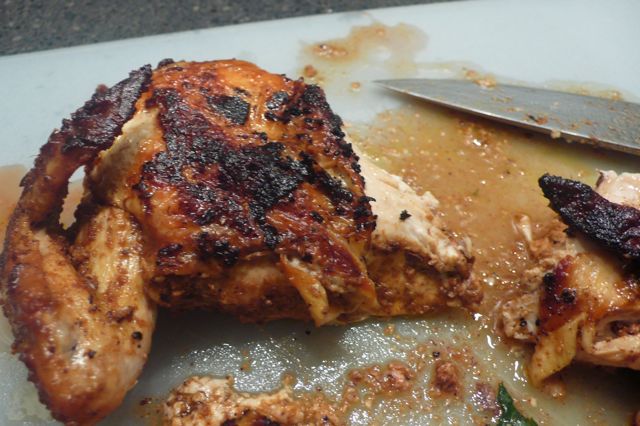
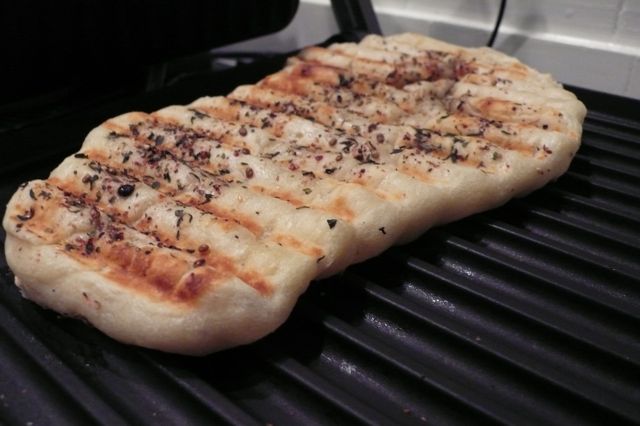
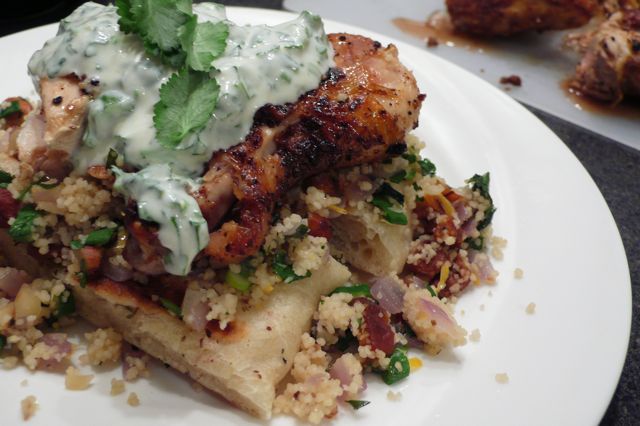
 But after all this, I was tempted to make focaccia. Never made it before, and bread is always a little daunting, but what’s the worst that could happen- over-yeasting? wasting bread flour? I went straight for the recipe in The Bread Baker’s Apprentice; the recipe was not read aloud by any annoying computer voice and no paper clips barged in on my baking. Without a computer, I was miraculously able to turn out a rather spectacular focaccia, if I do say so myself. Still warm from the oven, I cut wedges of the loaf in half, slathered them with fig jam, some hot coppa, a little asiago and grilled them melty on the Foreman. Crisp, chewy perfection.
But after all this, I was tempted to make focaccia. Never made it before, and bread is always a little daunting, but what’s the worst that could happen- over-yeasting? wasting bread flour? I went straight for the recipe in The Bread Baker’s Apprentice; the recipe was not read aloud by any annoying computer voice and no paper clips barged in on my baking. Without a computer, I was miraculously able to turn out a rather spectacular focaccia, if I do say so myself. Still warm from the oven, I cut wedges of the loaf in half, slathered them with fig jam, some hot coppa, a little asiago and grilled them melty on the Foreman. Crisp, chewy perfection.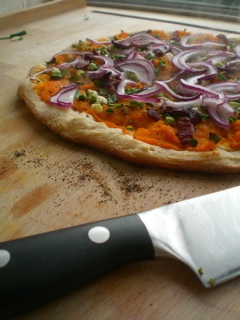 After the failure of the
After the failure of the  If you look carefully, you’ll notice one item on this list is not crossed off; we finally found a food that the magical land of Berkeley could not provide. Of all things, goat. I even called around to butchers and halal meat markets, and the artisan butcher at the market; the best response I got was to “try again around Easter”. And I’m not sure, but I think that’s because the Muslim holiday of Id-al-Adha, at which much goat feasting occurs, might fall in early April(??). I could be wrong, maybe that’s just when baby goats are at their most tender. (Meat is Murder. Tasty, tasty murder.)
If you look carefully, you’ll notice one item on this list is not crossed off; we finally found a food that the magical land of Berkeley could not provide. Of all things, goat. I even called around to butchers and halal meat markets, and the artisan butcher at the market; the best response I got was to “try again around Easter”. And I’m not sure, but I think that’s because the Muslim holiday of Id-al-Adha, at which much goat feasting occurs, might fall in early April(??). I could be wrong, maybe that’s just when baby goats are at their most tender. (Meat is Murder. Tasty, tasty murder.) Nevermind that it is the middle of summer and hot as an oven inside our west-facing kitchen in the evenings, I could just imagine the delicate, slightly gamey, savoury taste of this slow-cooked, oven-braised meat over pasta. It had to be done.
Nevermind that it is the middle of summer and hot as an oven inside our west-facing kitchen in the evenings, I could just imagine the delicate, slightly gamey, savoury taste of this slow-cooked, oven-braised meat over pasta. It had to be done. Did I mention that I made bread to go with it? My first ever attempt at bread making: pain à l’ancienne, a crispy, chewy baguette which, by the way, turn into rock solid pieces of fossilized bread if you leave them out overnight wrapped in towel. But I digress. The resulting meal that we enjoyed the following day was marvelously decadent and the only thing that could possibly have made it better was if it was cold outside.
Did I mention that I made bread to go with it? My first ever attempt at bread making: pain à l’ancienne, a crispy, chewy baguette which, by the way, turn into rock solid pieces of fossilized bread if you leave them out overnight wrapped in towel. But I digress. The resulting meal that we enjoyed the following day was marvelously decadent and the only thing that could possibly have made it better was if it was cold outside.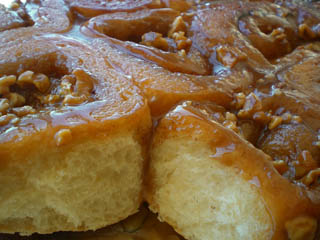 I was eyeing a bread baking book at Chapters before leaving on our around the world trip. Now that we’ve returned and I’ve been making bread again, I picked up
I was eyeing a bread baking book at Chapters before leaving on our around the world trip. Now that we’ve returned and I’ve been making bread again, I picked up 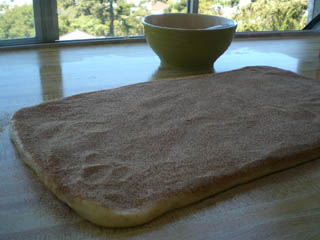 gave Janet a heart attack and that was in addition to the 1/2 cup of sugar that was rolled into the buns. Baking the buns was a bit of a challenge because the dough need to cook through to the bottom and the glaze needs to carmelize without turning into rock candy. In the end, most of the glaze was a little too stiff, but still tasty. If I had rotated the pan half way through and took them out five minutes earlier, they would have been perfect bakery-quality buns. Surprisingly, the glaze softened over the next 48 hours.
gave Janet a heart attack and that was in addition to the 1/2 cup of sugar that was rolled into the buns. Baking the buns was a bit of a challenge because the dough need to cook through to the bottom and the glaze needs to carmelize without turning into rock candy. In the end, most of the glaze was a little too stiff, but still tasty. If I had rotated the pan half way through and took them out five minutes earlier, they would have been perfect bakery-quality buns. Surprisingly, the glaze softened over the next 48 hours.